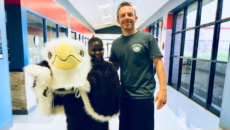Preschool
- Simply mention the words adoption or adopted occasionally as you talk about babies and families or tell stories.
- Enter into, or initiate, role plays about getting ready for the arrival of an adopted child, going to the airport to meet a new child, or going to court to have the adoption finalized.
- Choose stories to read which mention adoption.
- Make sure that the pictures and books in the classroom reflect the world’s diversity.
Early Elementary
- Read stories that are about adoption, as well as ones that mention adoption in passing.
- As you discuss different kinds of families, always mention adoptive families.
- If a student in the class has a baby born into their family, use this as an opportunity to mention that some children join families through adoption.
- Consider a class activity for National Adoption Awareness Month (November), such as having an adoptive parent visit.
- Be aware of potential confusion when the word adoption is used in connection with animals or fundraisers.
- Suggest that a different theme be used. Instead of “Adopt a Book,” try “Befriend a Book”; instead of “adopting an animal at a shelter,” talk of “finding an owner.”
[Instant eBook: Talking About Adoption]
Later Elementary
- Be sensitive to the fact that children of this age generally want to fit in and be the same as other children. They are unlikely to want to be singled out because they are adopted.
- Present the Family Tree exercise with several alternatives for the whole class, describing how adopted children have chosen to make their trees in the past.
- Mention that many famous people are adoptees: Moses, former President Gerald Ford, Stephen Jobs, Nelson Mandela, John Lennon, even Superman.
Middle & High School
- Suggest adoption as one of the themes for essay or journal writing. Allow students to explore their feelings.
- Introduce family history assignments sensitively, mentioning alternatives for everyone and noting that some students may not have access to their birth relatives, due to divorce, death, adoption, or for other reasons.
- Mention adoption in science class in connection with genetic studies, noting those traits, skills, and characteristics which are inherited and those which are acquired.
- In family life and sex education classes, discuss families formed by adoption. Explain adoption as a choice for people who face an unplanned pregnancy. Use positive adoption language and encourage students to do so.
- If a student says, I don’t see how anyone could place a child for adoption, talk about adoption as a loving choice.
[Talking About Adoption in the Classroom]
Books For Adults:
- Adoption and the Schools: Resources for Parents and Teachers, by Lansing Wood and Nancy Ng
- Being Adopted: The Lifelong Search for Self, by David Brodzinsky, Ph.D., Marshall Schechter, M.D., and Robin Henig
- Inside Transracial Adoption, by Gail Steinberg and Beth Hall
- Making Sense of Adoption: A Parents Guide and Raising Adopted Children, by Lois Ruskai Melina
- Real Parents, Real Children, by Holly van Gulden and Lisa M. Bartels-Rabb
- Talking with Young Children About Adoption, by Mary Watkins, Ph.D., and Susan Fisher, M.D.
- Telling the Truth to Your Adopted or Foster Child: Making Sense of the Past, by Betsy E. Keefer and Jayne E. Schooler
- The Open Adoption Experience, by Lois Ruskai Melina and Sharon Kaplan Roszia
- Twenty Things Adopted Kids Wish their Adoptive Parents Knew, by Sherrie Eldridge


